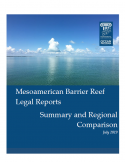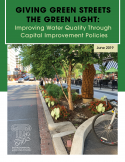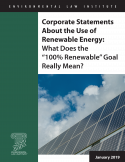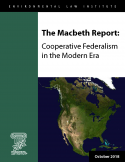
Research Reports
ELI publishes Research Reports available for free download that present the analysis and conclusions of the policy studies ELI undertakes to improve environmental law and policy. These reports contribute to education of the profession and disseminate diverse points of view and opinions to stimulate a robust and creative exchange of ideas. Those publications, which express opinions of the authors and not necessarily those of the Institute, its Board of Directors, or funding organizations, exemplify ELI’s commitment to dialogue with all sectors.
This document was prepared by the Environmental Law Institute in partnership with Rare. The legal reports for Belize, Guatemala, Honduras, and Mexico – the four countries of the Mesoamerican Barrier Reef (MAR) – cover aspects of fisheries and marine management laws that set out the framework for protecting the sustainability of small-scale fisheries, marine ecosystems, and the livelihoods of the fisherfolk who depend upon them.
Read More >
The vast majority of assessed water bodies across the United States are designated as impaired. Cities contribute to the problem with stormwater runoff from roads, buildings, sidewalks, and other impervious surfaces polluting our rivers, lakes and streams. Indeed, many localities are on the hook to meet a gamut of regulatory requirements, from MS4 permits to TMDLs in order to reduce polluted runoff. Innovative localities are turning to green infrastructure practices to reduce flooding, control erosion, and prevent polluted runoff from entering streams and other waterbodies.
Read More >
There is a movement among companies to use more renewable energy and less energy obtained from fossil fuels. Some are pledging to go “100% renewable”, with companies joining such groups as RE100, signing on to Corporate Renewable Energy Buyers’ Principles, and undertaking other initiatives. At least 150 large companies, including Apple, Facebook, and Google, among others, have set goals to rely exclusively on renewable energy. Many others have set goals to rely on substantial percentages of renewable energy in portions of their operations or in certain locations.
Read More >
Policy professionals and the public who care deeply about the success of the United States’ environmental protection enterprise recognize that current challenges to the system demand both careful reflection and concerted action. Many changes over recent years have brought the United States to a point where our environmental system may be ready for some fundamental realignments, including changes in states’ capacity, technological capabilities, and business behavior and expectations.
Read More >
In cellular agriculture research, development and commercialization since 2013 have transformed the prospects for the future of food production, particularly regarding animal-based agriculture. With the first cultured burger taste-tested in London in August 2013, advances in cultivating meat through cellular agriculture have grown and expanded capturing the attention of the press, the public, and investors.
Read More >